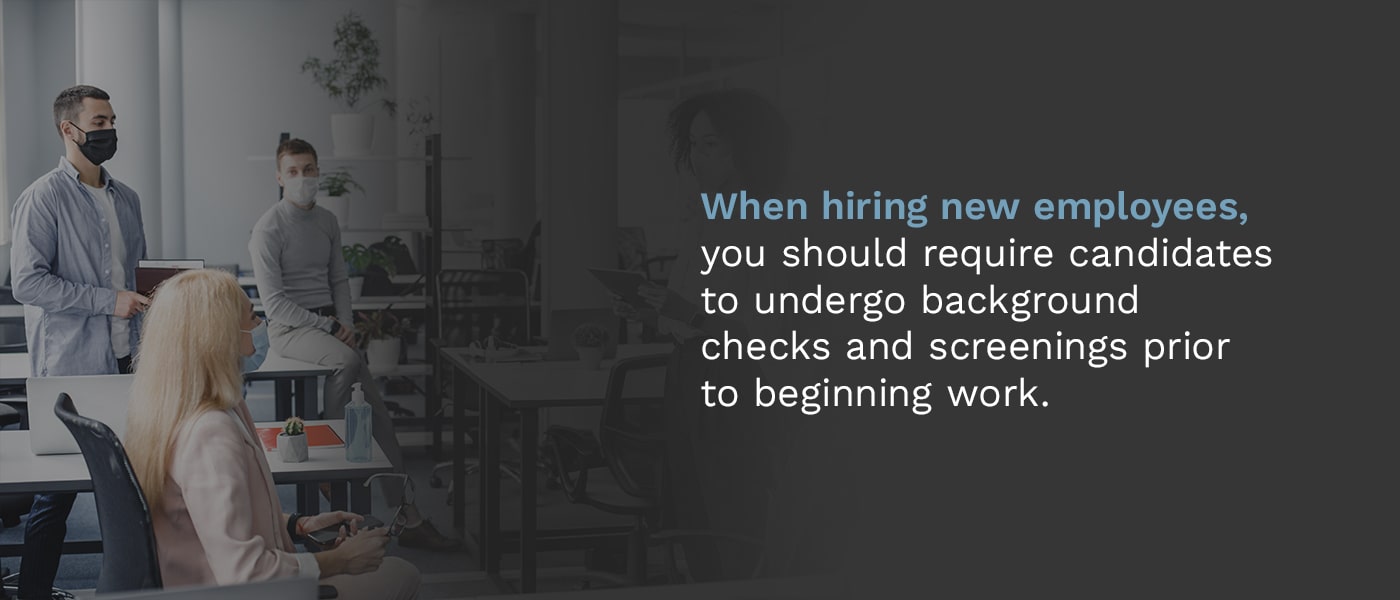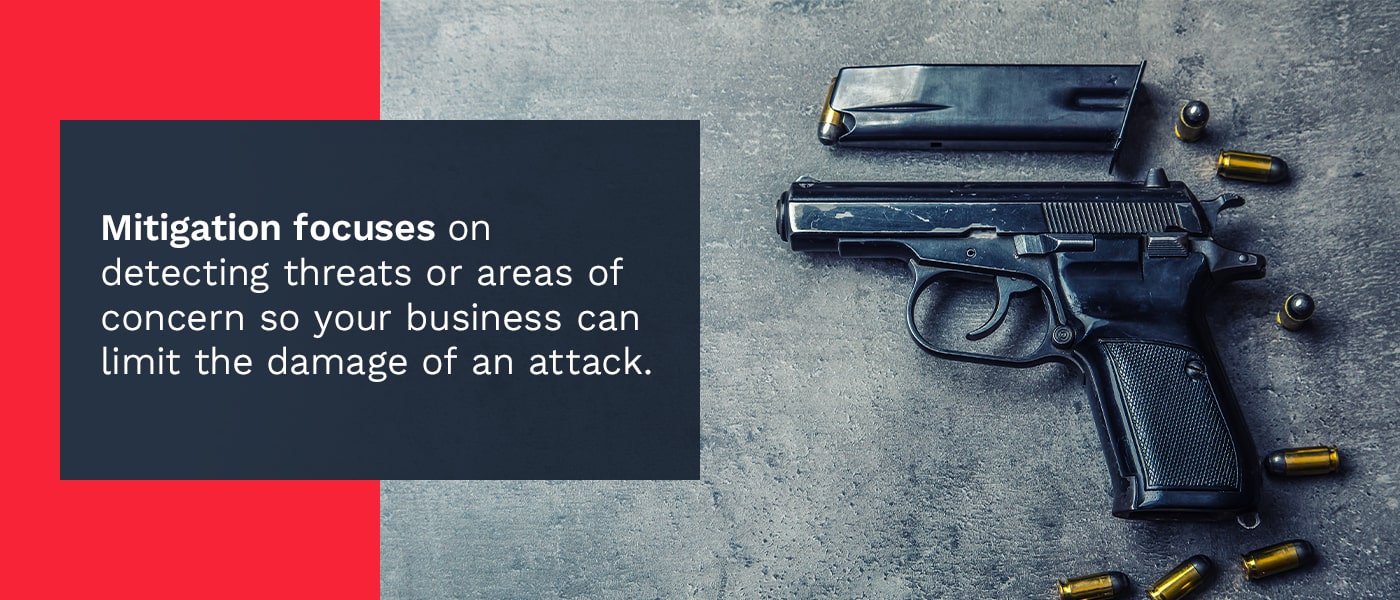
How to Prepare Your Business for an Active Shooter
Because of the seemingly random nature of active shooter events, every business should be prepared for the worst-case scenario. There has been an upward trend of active shootings in the United States, with 40 situations occurring in 2020. Because almost any place of business could experience a shooting, businesses need to know how to prepare for an active shooter event to help minimize the casualties and damage before they occur.
How to Prepare for an Active Shooter Event at Your Business
While it’s something no one wants to imagine happening, preparing for an active shooter can be the difference between life and death. In most cases, active shooter incidents end within 10-15 minutes, often ceasing before local law enforcement can arrive. This timeframe makes preparation even more critical, as you’ll want to give employees and customers the tools and techniques to help them get into survival mode immediately.
The following are recommended strategies for how businesses can prepare for an active shooter incident:
1. Plan to Prevent
Despite active shootings being largely random, you can implement a few strategies to prevent such events from occurring. When creating a plan for your place of work, you should aim to make prevention one of the most important points. This process starts with employees and culture.
When hiring new employees, you should require candidates to undergo background checks and screenings prior to beginning work. This precaution can help to identify potential individuals of concern. Creating an inclusive and positive work environment where all workers feel respected can also help prevent employees from becoming disgruntled or violent towards the business or other coworkers.
Additionally, it’s best practice for businesses to have an effective system in place for reporting signs of violent behavior. Whether it’s speaking with a human resources representative or filing an anonymous report, keeping an eye out for indications of violent behavior can help management take action before an incident occurs.
While no situation will have the same indicators, you may notice red flags like:
- Traumatic life events, such as loss of employment, death of a loved one or a divorce
- Signs of mood swings, depression or withdrawal
- Increased or heavy alcohol and/or drug use
- Paranoid behavior
- Being a victim of workplace harassment or bullying
- Extreme reactions to policy or procedure changes
- Past aggressive behaviors
- An obsession with past attacks or shootings
- Displays of empathy for other violent individuals
- Odd comments regarding weapons, violent crimes and firearms
There are certainly more warning signs, and the signs listed won’t always indicate a potential threat. Regardless, being aware of possible signs of violent behavior can aid in preventing an active shooter event. Be sure to help all the employees at your business understand what red flags for violent behavior can look like.
2. Provide Protection and Training to Employees
There are several actions businesses can take to help provide protection to employees. The best way to protect employees in an active shooter situation is to provide them with training resources now so they’ll be prepared if an incident occurs in the future. Create an emergency action plan (EAP) and ensure all employees are familiar with the plan, which includes all potential hazards and how to face them appropriately.
To help your employees prepare and train for such an event, identify all possible exits from the building and highlight possible escape routes from areas in your facility. Keep escape route signs posted in areas around your business as a reminder in an emergency situation. As a team, identify potential places to hide if escape isn’t possible. Consider discussing what could be used as a weapon in the event someone may have to fight the intruder.
Be sure to provide each employee with a copy of your EAP and review it as a team annually to discuss changes. EAPs should be discussed in new hire training and orientations to ensure everyone working in your environment is aware of the emergency plan. Upon completion of your EAP, practicing the techniques laid out in the plan is an effective way to ensure staff members understand the plan.
If you’re unsure how to approach training your employees about active shooter events, you may want to hire someone to educate your company with alert, lockdown, inform, counter, evacuate (ALICE) training or a similar program.
3. Mitigate Threats
Mitigation focuses on detecting threats or areas of concern so your business can limit the damage of an attack. These efforts are essentially ways to reduce the impact an incident has on your employees and business. Even though much of an active shooter scenario will be out of your control, it’s important to know how you can decrease threats in your business to try and anticipate what your employees should do.
A business threat assessment can help you to identify potential dangers. How secure is your building? Do you have alarm systems or video surveillance? Do you employ on-site security staff? Consider partnering with local law enforcement to assess your facility and test your EAP. Conducting an active shooter drill effectively tests your plan and trains employees in active shooter preparedness.
With the expertise of a trained officer, you can practice escape routes, hiding places and more. These professionals will be able to identify areas of weakness in your plan and your facility as a whole so you can make adjustments before a live incident occurs. For example, they can recommend areas where you should increase surveillance or add electronic keys and locks to prevent unauthorized individuals into the building or certain areas of the facility.
Having emergency responders come to your business also helps them familiarize themselves with your facility’s layout in case they’d ever be called to respond to an emergency situation there. As a result, they’ll be able to jump into action more quickly if the need ever arises.
4. Create a Response Protocol
Creating a response protocol ensures your employees know how to properly respond and act in an active shooter situation. It’s smart to include a response protocol in your EAP to ensure it’s standardized across your company and documented in an easily accessible location. This response protocol should include when to alert others, how to communicate during an active shooter event and the proper run-hide-fight procedures.
Empowered Employees
In many cases, employees ignore hints of possible danger, and when they go unreported, it can endanger the entire workplace. Ensure your employees feel comfortable looking for signs of potential violence — and more importantly, feel comfortable alerting coworkers. Empower employees to report any possible threat. Even if it turns out to be a false alarm, it’s better to be safe than risk a violent attack.
If staff members feel uncomfortable alerting the entire company of a potentially small threat, encourage them to at least report it to their superiors so they can evaluate the issue.
Methods for Communicating
When it comes to workplace crises, communication is critical. One of the most valuable tools a business can have is an emergency notification system. Whether it’s through pushing a button to sound an alarm, a computer monitor pop-up notification or mass text messaging, you should be able to reach every employee.
Some characteristics of quality emergency communication systems include:
- Two-way messaging: This feature allows employees to respond to the alert to request help, send updates and share their locations. These capabilities are helpful to first responders so they know where injured victims are and where staff members are hiding.
- Multi-channel alerts: The ability to send notifications across various communication channels is extremely beneficial in a crisis situation. If your alerts are only sent out via a single channel, you risk some employees missing the notification. With multi-channel notifications, urgent information can be sent out and accessed quickly via whatever channel is readily accessible to employees around your facility.
- Mobile apps: Mobile apps and notifications allow management and employees to send and receive emergency alerts on their mobile devices. This feature can serve as another channel to receive alerts from and notify employees who are out-of-office, whether for lunch, meetings or time off. Mobile alerts can save employees from walking into a dangerous situation when they’d be better off staying away from the building.
Ultimately, communication should happen quickly and efficiently so your employees have a greater chance of getting to safety.
When to Run, Hide or Fight
The run-hide-fight protocol is a fairly standard method for responding to an active shooter in the workplace. These options should be practiced in training to ensure your employees know what to do. Remind them of these best practices:
- Run: Running from an active shooter is the best option when possible. Knowledge of evacuation routes and whether they’re clear for a safe escape is essential. If employees feel they can safely reach an exit, they should move as quickly and quietly as possible. While it’s best to try and get coworkers and others to follow suit, staff members should avoid wasting too much time trying to convince others to leave. Remind your employees they should leave behind all personal belongings and focus on saving themselves. When they reach safety, they should immediately contact the police.
- Hide: If it’s unsafe for employees to run, they should shelter in place. Instruct employees to find a room that has few windows and can be locked from the inside. They should shut off lights, silence phones and barricade the door with heavy furniture. Remind your employees that if they choose to hide, they should remain in their hiding place until law enforcement reaches them or clears the facility.
- Fight: The fight response should only be used as a last resort. If employees are confronted by the shooter, they should be prepared to fight. Instruct them to do so in groups so they have a chance to outnumber and discourage the assailant and keep fighting until they’re sure they’re safe. Remind your employees to use anything around them that could serve as a weapon to defend themselves.
Additionally, train your employees how to safely exit the building as law enforcement is entering. Ensure they know to exit as calmly as possible with their hands in the air and avoid stopping the police, since their main goal is to locate the shooter. Equipping your employees with this knowledge will give them a fighting chance to survive an active shooter event.
5. Build a Recovery Plan
The last element of active shooter preparedness for businesses is to create a recovery plan ahead of time. Whether it’s outlined in your EAP or is its own document, a recovery plan will make the transition back into the workplace more manageable. The time after an active shooter event can be overwhelming and confusing for everyone involved.
Make sure you have a way to communicate accurate information to your employees, as incorrect information can delay the recovery process. The recovery plan should outline where information will be posted for employees to access crisis details and communicate with each other. This information can help employees feel less isolated and stay aware of the situation as it pertains to them.
Be sure to prepare your business for long-term recovery. Consider these four categories when planning for the long term:
- Financial: How will you sustain your business while your employees are recovering? What kind of compensation will your employees receive as they need time to recover?
- Services: If your human resources department lacks the capacity to assist everyone properly, where will they go? Will you provide services for them, and if so, how much will you cover?
- Psychological: How will you help your employees recover emotionally?
- Physical: How will you help them recover if they sustained physical injuries? Will you have to repair any physical damage to your business’s facility?
Other elements to consider for your recovery plan include who’s able to reopen the business when the time is right, sources you’ll use for relief funding, damage assessment documentation and how emotional first aid will be administered. With a recovery plan in place before an incident occurs, you’ll be able to more readily make the transition from response to recovery.
Get Active Shooter Insurance
While it’s tough to think about what your employees will need to do in an active shooter incident, the aftermath of a real incident is far more overwhelming. Getting active shooter insurance is among the best ways for businesses to prepare for an active shooter event. This kind of insurance is hard to find, which is why XINSURANCE is prepared to offer you custom solutions for active shooter insurance so you can gain peace of mind.
To find out how you can get coverage for physical damage, crisis management, and more, contact XINSURANCE today.

Rick J. Lindsey hails from Salt Lake City, Utah. He began working in the mailroom of his father’s Salt Lake City insurance firm, getting his introduction to the business that became his lifelong career. Rick J. Lindsey quickly rose through the ranks while working in nearly every imaginable insurance industry job. As an entrepreneur, specialty lines underwriter, claims specialist, risk manager, and a licensed surplus lines broker, Rick J. Lindsey is highly skilled in all levels of leadership and execution. As he progressed on his career path, Rick J. Lindsey discovered an urgent need for insurers willing to write policies for high-risk individuals and businesses. He was frequently frustrated that he could not provide the liability protection these entities desperately needed to safeguard their assets. He also formed the belief that insurance companies acted too quickly to settle frivolous claims. Rick J. Lindsey decided to try a different approach. He started an insurance company and became the newly formed entity’s CEO. This opportunity has enabled Rick J. Lindsey to fill a void in the market and provide a valuable service to businesses, individuals, and insurance agents who write high-risk business. XINSURANCE also specializes in helping individuals and businesses who live a lifestyle or participate in activities that make them difficult for traditional carriers to insure. If you’ve been denied, non-renewed, or canceled coverage, don’t give up quite yet. Chances are XINSURANCE can help.





